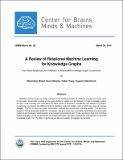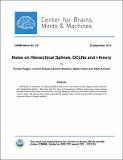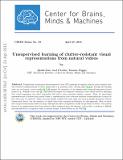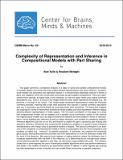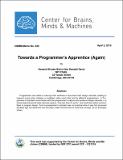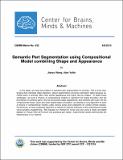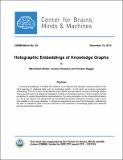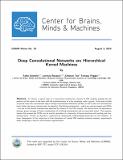Search
Now showing items 1-10 of 18
A Review of Relational Machine Learning for Knowledge Graphs
(Center for Brains, Minds and Machines (CBMM), arXiv, 2015-03-23)
Relational machine learning studies methods for the statistical analysis of relational, or graph-structured, data. In this paper, we provide a review of how such statistical models can be “trained” on large knowledge graphs, ...
UNSUPERVISED LEARNING OF VISUAL STRUCTURE USING PREDICTIVE GENERATIVE NETWORKS
(Center for Brains, Minds and Machines (CBMM), arXiv, 2015-12-15)
The ability to predict future states of the environment is a central pillar of intelligence. At its core, effective prediction requires an internal model of the world and an understanding of the rules by which the world ...
Notes on Hierarchical Splines, DCLNs and i-theory
(Center for Brains, Minds and Machines (CBMM), 2015-09-29)
We define an extension of classical additive splines for multivariate function approximation that we call hierarchical splines. We show that the case of hierarchical, additive, piece-wise linear splines includes present-day ...
Unsupervised learning of clutter-resistant visual representations from natural videos
(Center for Brains, Minds and Machines (CBMM), arXiv, 2015-04-27)
Populations of neurons in inferotemporal cortex (IT) maintain an explicit code for object identity that also tolerates transformations of object appearance e.g., position, scale, viewing angle [1, 2, 3]. Though the learning ...
Complexity of Representation and Inference in Compositional Models with Part Sharing
(Center for Brains, Minds and Machines (CBMM), arXiv, 2015-05-05)
This paper performs a complexity analysis of a class of serial and parallel compositional models of multiple objects and shows that they enable efficient representation and rapid inference. Compositional models are generative ...
Towards a Programmer’s Apprentice (Again)
(Center for Brains, Minds and Machines (CBMM), 2015-04-03)
Programmers are loathe to interrupt their workflow to document their design rationale, leading to frequent errors when software is modified—often much later and by different programmers. A Pro- grammer’s Assistant could ...
Semantic Part Segmentation using Compositional Model combining Shape and Appearance
(Center for Brains, Minds and Machines (CBMM), arXiv, 2015-06-08)
In this paper, we study the problem of semantic part segmentation for animals. This is more challenging than standard object detection, object segmentation and pose estimation tasks because semantic parts of animals often ...
Holographic Embeddings of Knowledge Graphs
(Center for Brains, Minds and Machines (CBMM), arXiv, 2015-11-16)
Learning embeddings of entities and relations is an efficient and versatile method to perform machine learning on relational data such as knowledge graphs. In this work, we propose holographic embeddings (HolE) to learn ...
Deep Convolutional Networks are Hierarchical Kernel Machines
(Center for Brains, Minds and Machines (CBMM), arXiv, 2015-08-05)
We extend i-theory to incorporate not only pooling but also rectifying nonlinearities in an extended HW module (eHW) designed for supervised learning. The two operations roughly correspond to invariance and selectivity, ...
Seeing is Worse than Believing: Reading People’s Minds Better than Computer-Vision Methods Recognize Actions
(2015-12-10)
We had human subjects perform a one-out-of-six class action recognition task from video stimuli while undergoing functional magnetic resonance imaging (fMRI). Support-vector machines (SVMs) were trained on the recovered ...

